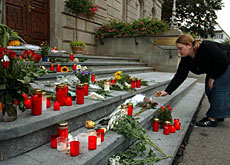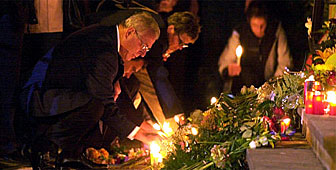Zug gunman was “cold-blooded” killer

The man behind Switzerland’s worst-ever massacre acted in cold blood when he killed 14 people in Zug’s cantonal parliament in 2001.
Friedrich Leibacher also operated alone and died after turning a gun on himself, according to the final report into the bloodbath.
The publication of the findings by the canton Zug authorities comes a month after the second anniversary of the tragedy, which occurred on September 27, 2001.
Leibacher entered the parliament building wearing a police uniform and opened fire, killing three members of the cantonal government and 11 other parliamentarians, before shooting himself in the head. Fifteen other people were injured.
According to the report, the 57-year-old had a history of mental illness and frequently displayed psychopathic tendencies.
“His predisposition to acts of violence had been clear for some time,” said psychiatric expert Frank Urbaniok.
Urbaniok estimated that the gunman was in full possession of his faculties at the time of the shootings, adding that Leibacher had meticulously planned and executed the attack.
Death wish
An investigation into events prior to the massacre revealed that Leibacher was not counting on surviving the shootings.
During August and September 2001, he settled his financial affairs, closing his bank accounts and selling shares. He also prepared a will.
One day before the massacre, he instructed a Zurich funeral parlour that, in the event of his death, he wanted to be cremated and his ashes scattered over the Atlantic Ocean.
Around the same time, he wrote a farewell letter to his mother and left a note in his flat, stating that he would act alone on the “Tag des Zornes” or day of reckoning.
However, the police investigation also uncovered evidence that Leibacher might have had a getaway plan.
They found his car parked outside the Zug parliament building, with more guns and motorcycling gear stashed inside.
At the Zug train station, they discovered a motor scooter; Leibacher was carrying the keys.
Police powerless
The report exonerated the cantonal police, saying there was nothing they could have done to prevent the massacre.
And a post-mortem examination confirmed that the gunman had injuries consistent with shooting himself in the right temple.
Rumours have circulated that Leibacher was killed by a police marksman, fuelling allegations of a cover-up.
“The idea that a policeman or any other person grabbed the pistol and shot him has been ruled out,” said Roland Schwyter, the judge in charge of the inquiry.
Further tests – including those carried out on the victims – showed that the only ammunition used during the attack came from Leibacher’s weapons.
Shake-up
The killings prompted a review of public security, and led to calls for a tightening of Swiss gun laws, which are among the most liberal in the world.
Last month the justice minister, Ruth Metzler, said all guns should be centrally registered, sparking an outcry from the gun lobby and some politicians.
There are an estimated 1.2 million firearms in private hands in Switzerland and currently half a million Swiss men keep a rifle at home as part of the responsibilities under the militia army system.
One of the weapons used by Leibacher during the bloodbath was an army-issue assault rifle; all of the firearms in his possession were legally acquired.
swissinfo, Faryal Mirza
The Zug massacre led to calls for a shake-up of Swiss gun laws, said to be amongst the most liberal in the world.
There are more than a million guns in private possession in Switzerland.
More than half a million Swiss men have rifles at home because of the Swiss militia system.
Canton Zug has published its final report into the massacre of September 2001.
It concludes that the gunman, Friedrich Leibacher, was fully aware of what he was doing when he planned and executed the attack.
It also found Leibacher killed himself after murdering 14 parliamentarians in the Zug parliament building.
Eighteen others were seriously injured.

In compliance with the JTI standards
More: SWI swissinfo.ch certified by the Journalism Trust Initiative

You can find an overview of ongoing debates with our journalists here . Please join us!
If you want to start a conversation about a topic raised in this article or want to report factual errors, email us at english@swissinfo.ch.